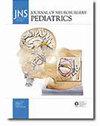Ventricular catheter tissue obstruction and shunt malfunction in 9 hydrocephalus etiologies.
IF 2.1
3区 医学
Q3 CLINICAL NEUROLOGY
引用次数: 0
Abstract
OBJECTIVE Hydrocephalus is a neurological disorder with an incidence of 80-125 per 100,000 births in the United States. The most common treatment, ventricular shunting, has a failure rate of up to 85% within 10 years of placement. The authors aimed to analyze the association between ventricular catheter (VC) tissue obstructions and shunt malfunction for each hydrocephalus etiology. METHODS Patient information was collected from 5 hospitals and entered into a REDCap (Research Electronic Data Capture) database by hydrocephalus etiology. The hardware samples were fixed, and each VC tip drainage hole was classified by tissue obstruction after macroscopic analysis. Shunt malfunction data, including shunt revision rate, time to failure, and age at surgery, were correlated with the degree of tissue obstruction in VCs for each etiology. RESULTS Posthemorrhagic hydrocephalus was the most common etiology (48.9% of total cases). Proximal catheter obstruction was the most frequent cause of hardware removal (90.4%). Myelomeningocele (44% ± 29%), other congenital etiologies (48% ± 40%), hydrocephalus with brain tumors (45% ± 35%), and posthemorrhagic hydrocephalus (41% ± 35%) showed tissue aggregates in more than 40% of the VC holes. A total of 76.8% of samples removed because of symptoms of obstruction showed cellular or tissue aggregates. No conclusive etiological associations were detected when correlating the percentage of holes with tissue for each VC and age at surgery, shunt revision rates, or time between shunt implantation and removal. CONCLUSIONS The proximal VC obstruction was accompanied by tissue aggregates in 76.8% of cases. However, the presence of tissue in the VC did not seem to be associated with hydrocephalus etiology.9 种脑积水病因中的脑室导管组织阻塞和分流器故障。
目的脑积水是一种神经系统疾病,在美国的发病率为每 10 万名新生儿中有 80-125 例。最常见的治疗方法--脑室分流术,在放置后 10 年内的失败率高达 85%。方法从 5 家医院收集患者信息,并按脑积水病因输入 REDCap(研究电子数据采集)数据库。对硬件样本进行固定,经宏观分析后按组织阻塞情况对每个 VC 头端引流孔进行分类。结果出血性脑积水是最常见的病因(占病例总数的 48.9%)。近端导管阻塞是最常见的硬件移除原因(90.4%)。髓样脑积水(44% ± 29%)、其他先天性病因(48% ± 40%)、脑瘤性脑积水(45% ± 35%)和出血性脑积水后遗症(41% ± 35%)在超过 40% 的 VC 孔中出现组织聚集。在因梗阻症状而移除的样本中,共有 76.8% 出现细胞或组织聚集。在将每种 VC 中带有组织的孔洞百分比与手术年龄、分流术修正率或分流术植入与移除之间的时间相关联时,没有发现确凿的病因关联。结论:在76.8%的病例中,VC近端梗阻伴有组织聚集,但VC中组织的存在似乎与脑积水的病因无关。
本文章由计算机程序翻译,如有差异,请以英文原文为准。
求助全文
约1分钟内获得全文
求助全文
来源期刊

Journal of neurosurgery. Pediatrics
医学-临床神经学
CiteScore
3.40
自引率
10.50%
发文量
307
审稿时长
2 months
期刊介绍:
Information not localiced
 求助内容:
求助内容: 应助结果提醒方式:
应助结果提醒方式:


